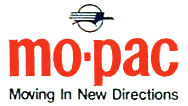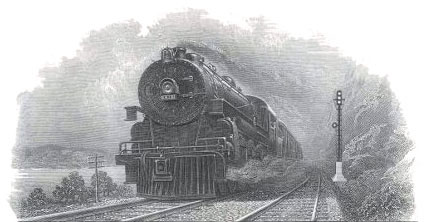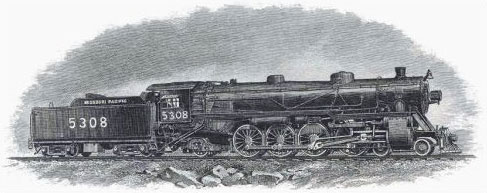This website has been archived from TrainWeb.org/screamingeagle to TrainWeb.US/screamingeagle.
|
||||
| HOME Power Cabooses Rolling Stock MoW Depots | ||||
ABOUT
MISSOURI PACIFIC On July 4, 1851 at St. Louis, Missouri, ground breaking for the Pacific Railroad Company marked the beginning of what would later be known as the Missouri Pacific Railroad Company (1849-1872), becoming the first railroad west of the Mississippi River. The The first section of track completed in 1852. It was the first railroad to serve Kansas City, reached in 1865, after construction was interrupted by the American Civil War. In 1872
the railroad was reorganized as the Missouri Pacific Railway, and in 1879
it came under the control of New York financier Jay Gould, who developed
a system extending through Colorado, Nebraska, Arkansas, Texas, and Louisiana.
In 1917 the line was merged with the St Louis, Iron Mountain and Southern
Railway Company and reorganized as the Missouri Pacific Railroad. Later
it acquired and controlled other lines in the Gulf area and in Texas including
the Texas & Pacific, extending its operating area to several midwestern
and southwestern states. The line's popularly known Eagle passenger operations, were turned over to the National Railroad Passenger Corporation (Amtrak) in 1971. By the 1980's the system would own 11,469 miles of railline over 11 states bounded by Chicago to the east, Pueblo out west, north to Omaha, south to the Mexico border in Laredo and southeast along the Gulf seaports of Louisiana. MoPac operated a fleet of over 1,500 diesel units, most all were purchased within the previous 10 years. The company was a pioneer in the early days of computer-guided rail technology. It was a major hauler of grain, TOFC, coal, ore, autos and dry goods. By the time of the mega-merger, the MoPac owned newer/more locomotives and operated more track than partner Union Pacific. On December 22, 1982 the Missouri Pacific merged with Union Pacific and Western Pacific Railroad companies to create the largest system in its day, the "Union Pacific System", under the holding company Union Pacific Corporation, but maintained its own corporate and commerical identity.
If this site has any kind of mission statement it's to provide a broad range of information and promote the accurate recounting of MoPac's role as a major player among the Class 1 roads in it's long history. A robust company at the time of it's merger with UP, it was larger than UP, rostered more and newer locomotives, and an innovator of the industry. While other roads were content to do what everyone elase was doing (and many would pay the price for this thinking back during the reccession of the 1970's), the Missouri Pacific stayed true to it's philosophy of building a better, more innovative system. Instead of holding onto it's money, it was put back into the railroad. New ideas and new ways of operating were encouraged. Finally, the company had predicted an age of mergers to come and long held a desire to merge with another Class I, thus avoiding a certain future of being left on the sidelines. You won't see that fact in many exhaustive rail histories, and we're only scratching the surface. The Missouri Pacific had it's own style of railroading -- which many of us have long missed. If you ever come across
a fact stated on this site which is inaccurate, please
tell me. I've tried to preserve history unenhanced to the best of
my knowledge, but I'm sure there's plenty of room for improvement.
To Learn More About MoPac: Local History I Factsheet I Divisions I Mergers I Rosters I Maps
|
|
trainweb.us/screamingeagle l Last Update
to this page: 16 April, 2008
|
|
| All images & text © 2000-2008 T. Greuter / Screaming Eagles, unless otherwise noted. All Rights Reserved. | |



















